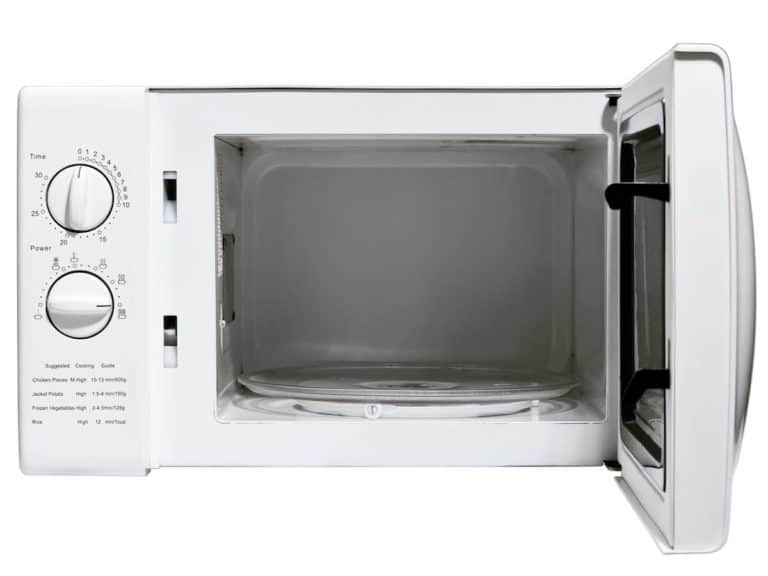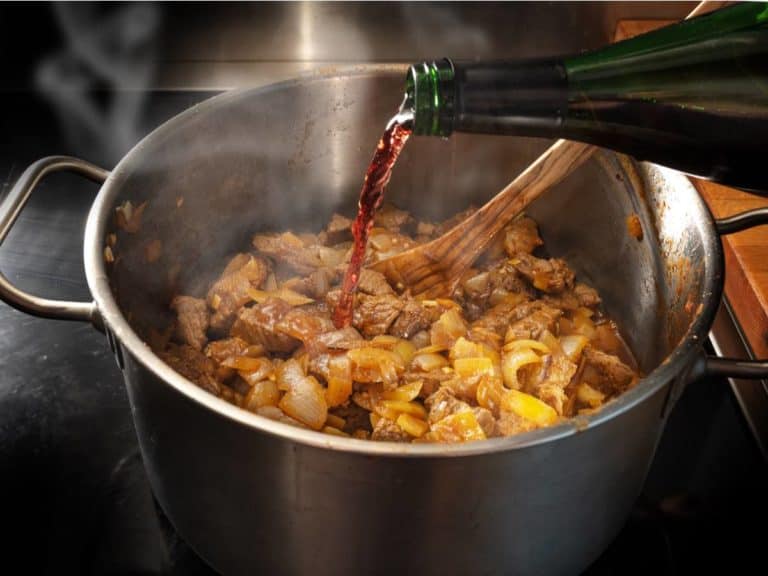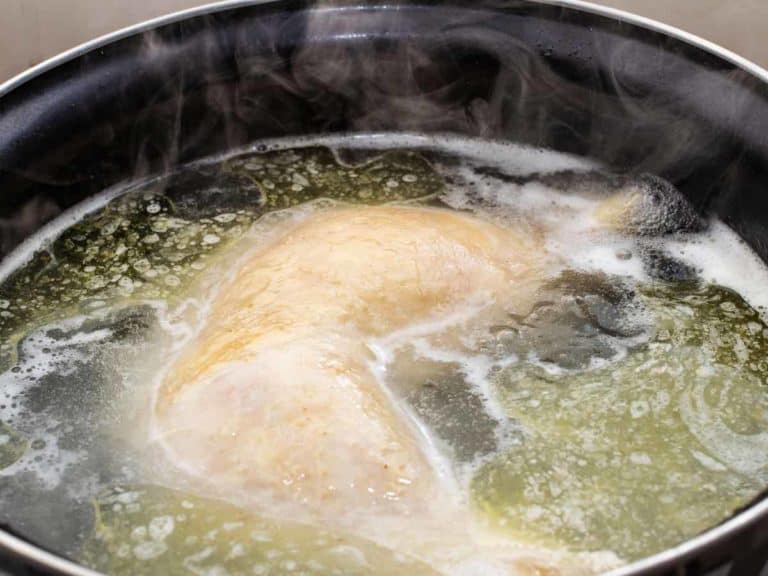Did You Know These 8 Cool Horseradish Root Tips?
Did you know that more than 95% of wasabi served at sushi restaurants is made from horseradish and some other ingredients and does not even have wasabi in them?
Just like wasabi, horseradish packs a punch.
And if you are planning on adding horseradish to your diet as store-bought or homemade prepared horseradish, keep reading. That’s because this post is all about this cruciferous vegetable that, despite what it’s called, has absolutely nothing to do with horses — those galloping creatures absolutely hate horseradish because it is poisonous to them.
Below, you will come across 8 tips on preparing, storing and eating horseradish root — plus a bunch of quick tips in some of them — that will help you introduce it into your kitchen with much ease.
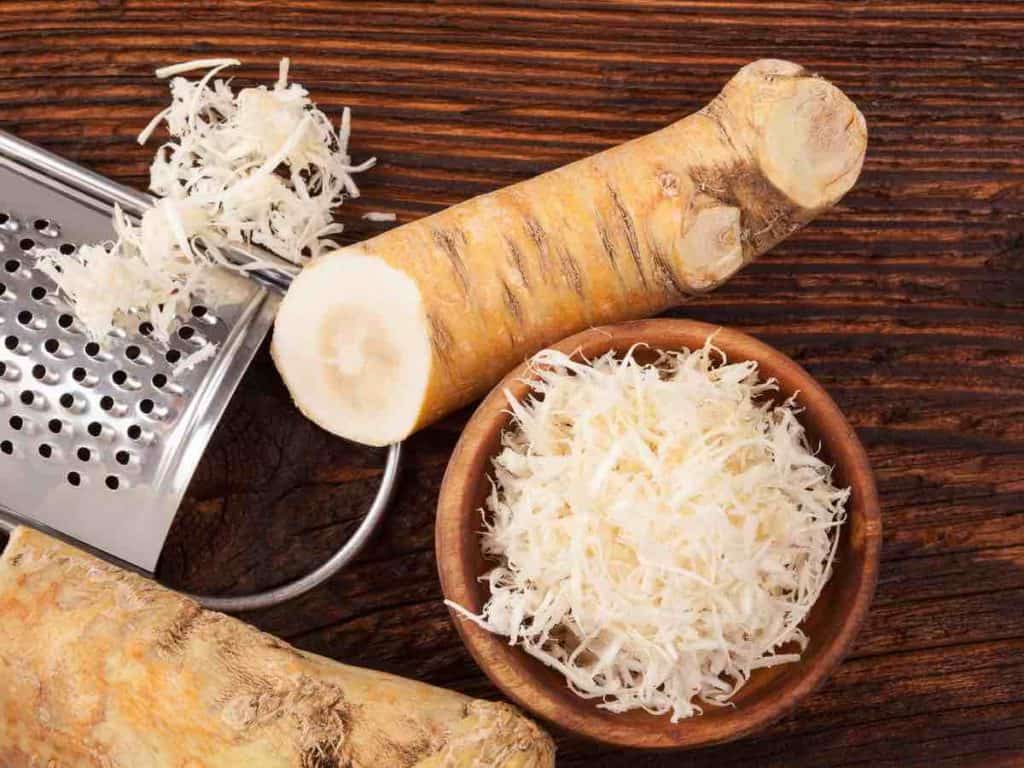
Eat Horseradish Root for Optimum Health
In some parts of the world, horseradish root is consumed as a vegetable. In others, it’s commonly added to the diet as a condiment or sauce. Different cultures prefer to consume the root crop in different manners.
And you may be craving for an answer to this question…
Is horseradish root healthy?
Like many root vegetables, horseradish root is healthy. It’s packed with vitamin C and contains minerals such as calcium, potassium, magnesium and zinc. Horseradish is also loaded with antioxidants, which are compounds that neutralize free radicals before they damage healthy cells of the body.
It is estimated that 49% of the population hates horseradish. If you’re one of them but consider yourself health-conscious, you will like the fact that horseradish roots have plenty of benefits to offer.
Some of the things you may enjoy by including it in your diet are:
- Increased circulation
- Decreased cancer risk
- Reduced inflammation
- Cleared airways
- Lowered UTI risk
- Improved digestion
- Decreased skin aging signs
Wait Out the Hotness of Horseradish Root
Like other spicy things, horseradish root can make your eyes water and your mouth feel like there’s a fire in it. But don’t panic — the intense effect lasts for only a few seconds. And this is why some people find prepared horseradish root (or even wasabi, which, as mentioned earlier, is actually out of horseradish root) somewhat addictive.
So, it comes naturally to answer this pressing question…
What makes horseradish root hot?
Horseradish root is hot because it contains a compound called isothiocyanate. It’s so volatile that it easily reacts with oxygen in the air and generates the heat horseradish is known to have. The compound is highly reactive to the saliva, too. Isothiocyanate remains inactive until horseradish root is grated or ground.
The reason why almost all wasabi at sushi restaurants all over the planet isn’t made from wasabi is that the plant, which is native to Japan, is extremely difficult to grow. Due to this, it doesn’t come cheap.
However, that’s alright since — believe it or not — wasabi is not as hot as horseradish root. If truth be told, wasabi has a sweeter and fresher flavor. It’s also more fragrant than horseradish root. But just like authentic wasabi, wasabi out of horseradish root creates an intense zing that doesn’t last that long.
Not All Horseradish Roots are Prepared Horseradish
Horseradish root that you can buy at the grocery store comes in all shapes and sizes. Two of the hottest sellers (pun intended) are fresh horseradish roots and prepared horseradish.
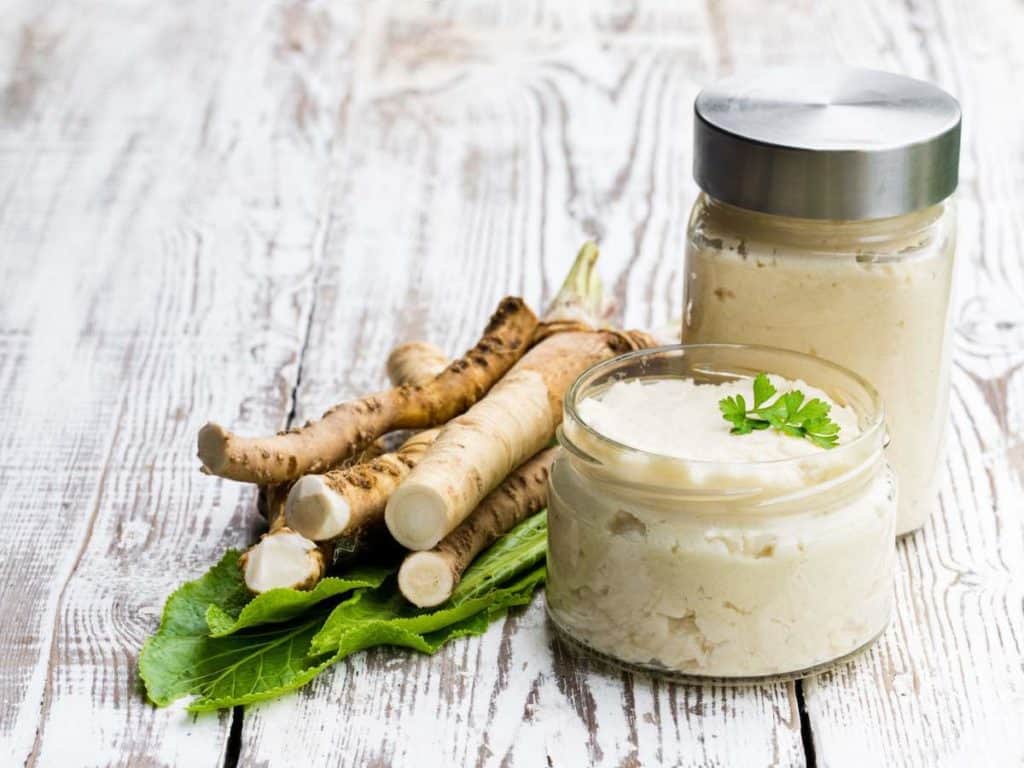
And this pressing question may be on your mind right now…
Fresh Horseradish vs. Prepared Horseradish: what’s the difference?
As the name suggests, fresh horseradish is horseradish that’s harvested and sold without undergoing any processing. Prepared horseradish, on the other hand, is grated horseradish root with vinegar and salt. Many horseradish products, such as horseradish sauce, are made from prepared horseradish.
Simply put, prepared horseradish is the condiment out of horseradish root that’s sold in a bottle.
Found in the condiment section at the supermarket, prepared horseradish can cost anywhere from as low as $3 to as high as around $40, depending on the size and blend.
Besides placing a bottle of prepared horseradish in your shopping cart, you can also simply opt for fresh horseradish root and then make prepared horseradish from scratch in your own kitchen. It only requires 3 ingredients, although the process can be kind of finicky because there are some precautions to bear in mind.
In a few, I will give you a basic homemade prepared horseradish recipe — so don’t stop reading now!
But before that, let’s answer this important horseradish shopping question…
Prepared horseradish vs. pickled horseradish: what’s the difference?
Prepared horseradish and pickled horseradish are one and the same. Both of them are grated fresh horseradish root with vinegar and a little salt. And because they are the same condiments, they have the same uses. They can be served with beef, pork and fish as well as with strong-flavored veggies.
By the way, prepared horseradish and pickled horseradish go by another name: horseradish relish. And that’s why when searching for prepared horseradish root recipes online, don’t be confused.
Water Reduces the Spiciness of Horseradish
Time and again, you have been told to avoid drinking water when your mouth is on fire — water will only spread the oil-based compounds in hot peppers, thus making the burning sensation worse. Milk, on the other hand, is perfect for the job as it’s capable of breaking down those piquant oils.
And this takes us to this question seeking an answer…
How do you neutralize the spiciness of horseradish root quickly?
Unlike capsaicin in hot peppers, the compound that makes horseradish root spicy is water-soluble. This is why drinking water can help put an end to the burning sensation in the mouth caused by the consumption of horseradish root. Drinking milk or having a teaspoon of sugar or honey is unnecessary.
As mentioned earlier, it doesn’t take a long time for the kick horseradish brings to wreak havoc on the mouth to dissipate — the intense sensation will go away after a few seconds.
But if you don’t want to wait, simply reach for a glass of water in order to put your suffering to a halt without any delay. It’s for the same reason why water may be used to neutralize some of the hotness when making homemade prepared horseradish. Or if there is no water in sight, just allow your saliva to deal with the burning sensation.
Put on Gloves When Handling Horseradish Root
Even though the hotness of horseradish root does not last as long as the hotness of hot peppers, it can still cause irritation. As a matter of fact, it can already leave you aggravated even before you consume prepared horseradish. That’s because peeled and sliced horseradish root can irritate your skin.
The importance of wearing gloves when handling fresh horseradish root cannot be stressed enough!
Buying a bottle of prepared horseradish is always a possibility. But if you are like many who prefer to enjoy homemade stuff in the kitchen, making prepared horseradish is always an option. As mentioned earlier, I will give you an easy-to-follow prepared horseradish recipe in a few.
But before that, here are some quick tips on preparing horseradish root…
How to peel horseradish root
Before peeling horseradish root, wash and scrub the root crop first. For the job, use warm water and a vegetable brush or any clean stiff-bristled brush available. Wash and scrub horseradish root for 30 to 60 seconds until clean. Use a small knife or vegetable peeler to remove the tough, woody skin.
How to cube horseradish root
In most instances, horseradish root is cubed before putting it in the food processor so that the kitchen appliance will be able to do its job faster and more efficiently. At times, it’s to store horseradish root in the freezer in small amounts. To cube the root vegetable, cut lengthwise and then crosswise after peeling.
How to grate horseradish root
After washing and scrubbing and peeling, horseradish root can be grated using a traditional grater. Employ a sturdy hand grater with small holes. Because grating horseradish root can be harsher on the eyes than chopping onions, consider wearing a pair of goggles or doing the grating task outside.
How to shred horseradish root
While horseradish root can be shredded using a hand grater, it’s a much better idea to use the food processor instead. This is especially true when large amounts of the vegetable have to be shredded at once. Install the right shredding disc to the food processor — with small holes or large holes — in order to obtain the desired texture.
How to grind horseradish root
Prior to grinding cleaned and peeled horseradish root, it’s recommended to cut the cruciferous veggie into small cubes first. It may also be shredded beforehand. This can make it so much easier to shred horseradish root to the right consistency, especially because it’s not particularly delightful to process it.
By the way, it’s not just your skin that horseradish root can irritate but also your eyes, nose and throat. That is why you should process horseradish root in a well-ventilated area of your kitchen or home.
Horseradish Root Should be Stored Properly
Just because horseradish root is a hardy vegetable doesn’t mean it doesn’t require proper storage. While it can be stored in the pantry or any other room-temperature area, horseradish root can be refrigerated, too.
Similar to most vegetables, you should wash horseradish root only when you are ready to use it.

Here’s the reason why washing before refrigerating should be avoided: it will introduce moisture to the veggie, which may make it easier for bacteria to grow and make it bad.
So, in other words, there’s no need to clean and scrub horseradish root before storing it in the pantry where it will last for 1 to 2 weeks. But it’s in the refrigerator where the root crop will last longer — up to 2 to 3 months. Before storing fresh horseradish root in the fridge, place it in a perforated plastic bag first.
And here’s an important question that must be answered…
Can you freeze fresh horseradish root?
Fresh horseradish root can be frozen to extend its shelf life. In the freezer, the veggie can stay in excellent condition for 4 to 6 months. However, there is a possibility for it to lose some of its pungency. Before freezing fresh horseradish root, wrap it in aluminum foil and place in a freezer-safe resealable bag.
In some instances, fresh horseradish root is grated, shredded or ground before freezing.
Processed horseradish root is also stored in small amounts in the freezer, each in its own small resealable freezer-safe resealable bag, so that one can thaw just what’s needed.
Refrigerate an Opened Prepared Horseradish Jar
Prepared horseradish root is commonly found in the condiments section at your favorite grocery store, sharing the aisle with ketchup, mustard, mayonnaise and others. The product, obviously, does not require refrigeration. Otherwise, you would come across it in the refrigerated section.
Online, however, it seems like everybody’s saying that you should refrigerate prepared horseradish. And this may leave you wondering who’s wrong — the grocery store manager or the rest of the population?
To put the confusion to an end once and for all, let’s answer this critical question…
How do you store prepared horseradish?
When storing store-bought prepared horseradish, consider whether the bottle has been already opened or not. An unopened jar of prepared horseradish may be stored at room temperature where it will keep until the best-by date. On the other hand, an opened container of prepared horseradish should be refrigerated.
Before deciding whether to stash a bottle of prepared horseradish you bought from your favorite grocery store in the pantry or the refrigerator, check out the best-by or best-before date on the packaging.
You can store the product in the pantry before that date for as long as it’s unopened.
Refrigerating prepared horseradish once its jar has been opened is the smart option. In the fridge, the product will stay fresh for 3 to 4 months. It will still be safe to consume it beyond that timeline. However, it will no longer boast of the same quality. In addition, and more importantly, it will no longer have the kick it used to have.
Meanwhile, homemade prepared horseradish root doesn’t have as long a shelf life as its store-bought counterpart — it can keep in the refrigerator for 2 to 3 weeks only.
Making Prepared Horseradish is Easy
Throughout the post, I mentioned that I will give you a prepared horseradish recipe that you can give a try whether it’s your first time making it in your own kitchen or you’re not completely pleased with the last one you tried.
So, without further ado, here’s the said recipe that yields half a cup or around 20 servings…
Ingredients:
- 5 ounces of fresh horseradish root
- 1 tablespoon of white vinegar
- Salt
- Water
Directions:
- Wash and scrub fresh horseradish root until very little to no dirt remains.
- Peel and chop horseradish root into roughly 1/2-inch cubes.
- Put chopped horseradish root in the food processor.
- Add 2 tablespoons of water.
- Process until horseradish root cubes are completely ground.
- Remove excess water if too runny or add a little water if too thick. Process again.
- Wait for about 3 minutes and then add the vinegar.
- Add a pinch of salt and pulse a few times.
- Transfer prepared horseradish to a small jar, cover and refrigerate.
Please take note that the vinegar locks in the hotness level of horseradish root — adding it before three minutes results in a less-hot homemade prepared horseradish, while adding it past 3 minutes results in a very hot one!
Before we end this post, let’s quickly answer a bunch of related questions…
Does sugar make horseradish hotter?
Adding sugar to homemade prepared horseradish makes it taste a little sweet. However, it will not make the product hotter or less hot. Again, it’s when you add the vinegar to the mix that determines the amount of punch prepared horseradish will have — the longer you wait, the hotter it gets.
By the way, sugar won’t stop the burning sensation in the mouth caused by prepared horseradish. Water will.
Are there substitutes for prepared horseradish?
There are a handful of products that can be used instead of prepared horseradish. Leading the list is wasabi, whether from actual wasabi or horseradish root. Wasabi powder or oil may be used, too. Hot mustard (powder or oil), ginger and black radish are other options as well.
No matter if you can’t get your hands on prepared horseradish or you don’t like it, there are alternatives around.
How do you eat prepared horseradish?
First and foremost, prepared horseradish is a condiment. This means you can pair it with an assortment of meats and fish. Adding it to stir-fried and steamed vegetables with strong flavors may be done, too. Prepared horseradish may also be added to sandwiches, certain sauces and some cocktails.
Having a jar of prepared horseradish, whether store-bought or homemade, lets you have a versatile condiment!
Above, I gave you 8 tips (plus some little ones) on preparing horseradish root and adding it to your diet.
Keep everything in mind, especially the ones about making homemade prepared horseradish and properly storing the product, no matter if store-bought or made in your kitchen, so that there’s a jar that you can easily reach for each time the dining table could use some punch and action.


